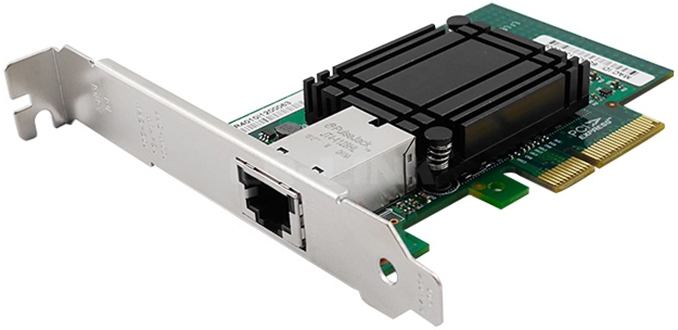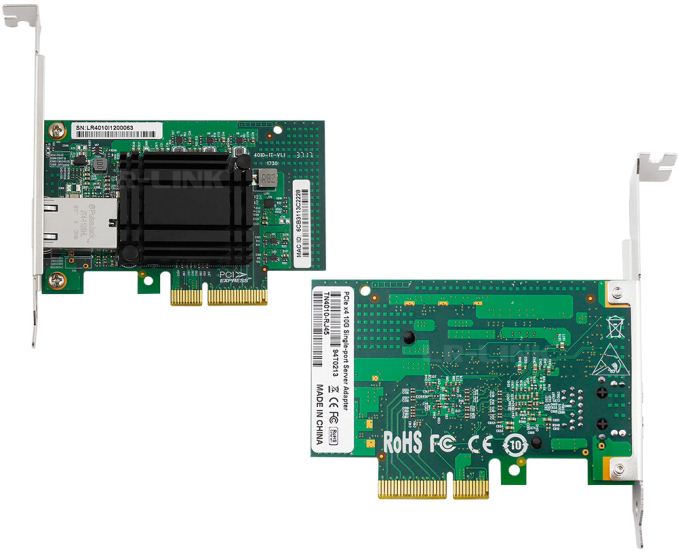LR-Link Launches New Mass-Market 10GigE NIC Based on Tehuti Networks’ Tech
by Anton Shilov on August 9, 2018 5:00 PM EST- Posted in
- Networking
- Marvell
- 10G Ethernet
- 10GBase-T
- Tehuti
- 10GbE
- LR-Link

LR-Link, a maker of networking solutions from China, has announced its first 10 GbE NIC, the wordy-named LREC6860BT. The new NIC is the first such retail product we've seen based on a design from Tehuti Networks, an Israel-based developer, bringing some more welcome competition to the 10GigE NIC market. LR-Link will be aiming at the (relative) mass-market for standalone NICs with this card, with the card now selling in Japan as well as online for less than $100.
Under the hood, the LR-Link LREC6860BT NIC is based on Tehuti Networks’ TN4010 MAC, which is further paired with Marvell’s Alaska X 88X3310P 10 GbE transceiver. The card features a PCIe Gen 2 x4 interface as well as an RJ45 connector that supports 100M, 1G, 2.5G, 5G, and 10G speeds using Cat5e/Cat6/Cat6A cabling. The card fully supports contemporary operating systems from Apple, Microsoft, and VMware as well as various Linux distributives. Therefore, the NIC is drop-in compatible with most computers that are in use today.
| LR-Link's 10 GbE NIC | ||
| LREC6860BT | ||
| Silicon | MAC | Tehuti Networks TN4010 |
| Transceiver | Marvell Alaska X 88X3310P | |
| 100BASE-T | Yes | |
| 1000BASE-T | Yes | |
| 2.5GBASE-T | Yes | |
| 5GBASE-T | Yes | |
| 10GBASE-T | Yes (over Cat6A cables) | |
| Ports | 1 | |
| OS Compatibility | Apple | MacOS 10.10.3 or later |
| Microsoft | Windows 7 / 8 / 8.1 / 10 or later Windows Server 2008 R2 / 2012 / 2012 R2 / 2016 R2 or later |
|
| VMware | Vmware ESX / ESXi 5.x / 6.x or later | |
| Linux | Linux Stable Kernel version 2.6.x/3.x or later | |
| Price | $83 - $91 | |
| Release Date | Q3 2018 | |
| Additional Information | Link | |
The LREC6860BT is currently available from at least one retailer in Japan for ¥10,164 ($91) with VAT, which is not very high considering the fact that PC components tend to cost more in Japan than in the rest of the world. Unfortunately products from LR-Link aren't readily available from retailers outside China and Japan, but the company’s devices (including the 10 GbE NIC) can still be purchased from official stores on AliExpress, Ebay, and JD.com.
10 GbE networks are not yet widespread in SOHO environments, primarily because there are not many reasonably-priced 10 GbE switches. Meanwhile, a number of companies have released their relatively affordable 10 GbE NICs based on chips from Aquantia over the past few quarters, anticipating demand for such cards from enthusiasts. Aquantia is not the only provider of solutions for inexpensive 10 GbE cards. Tehuti Networks is considerably less known because it is focused on working with enterprise OEMs rather than with AIBs and retail. Nonetheless, having a second player in the space for cheap 10GigE/NBASE-T silicon is an important part of driving down the cost of the technology –and boosting adoption – even further.
Related Reading:
- AKiTiO’s Thunder3 10G Adapter Now Available: TB3-to-10GbE for Sub-$300
- Aquantia’s Gamer Edition AQtion AQN-107 10 GbE NIC Available
- Aquantia to Sell Its 5G and 10G Network Cards for $59 and $69 on Black Friday
- ASUS Launches XG-C100C 10 GBase-T Adapter: Aquantia AQC107, $99
- GIGABYTE’s GC-AQC107 10G Ethernet PCIe Card Launched and Listed
Source: PC Watch











46 Comments
View All Comments
pixelstuff - Thursday, August 9, 2018 - link
If only cheap 2.5 GbE switches existed... I think I'd be happy enough.CaedenV - Friday, August 10, 2018 - link
Yep, 2.5gig Ethernet would be just fine for home use... It just needs to be faster than my spinning drives that I still have.iwod - Friday, August 10, 2018 - link
Well your spinning HDD could would still overflow your 2.5Gbps connection. I wish for 5Gbps.But from the looks of things Home NAS market isn't getting any bigger.
azazel1024 - Friday, August 10, 2018 - link
One spinning HDD is usually only pushing about 160MiB/sec and faster 7200rpm drives aren't really getting past 200MiB/sec. A single 2.5GbE link should be able to push about 300MiB/sec.So even a RAID0 array of a couple of hard drives might not fully saturate a 2.5GbE link
iwod - Sunday, August 12, 2018 - link
I stand corrected. Somewhere in the back of mind I remember they were doing 2xxMB/s already. Turns out only those newest 12TB manage to just touch 200MB/s read and write.Then yes, 2.5Gbps is good right now.
abufrejoval - Friday, August 10, 2018 - link
Has anyone had any experience with the Netgear MS510TX?They are NBASE-T and support 2x 2.5, 2x 5, 1x 10 and 4x 1 Gbit at 26 Watts max power.
If that fan is well designed and variable, it might have acceptable noise levels...
I seems it's actually being phased out already, because I only managed to find it when looking explicity for that product, not by navigating their site top down.
mode_13h - Monday, August 13, 2018 - link
I'd be happy with 4 fast ports. 2 isn't enough, but I don't need 8, or even 5.AdrianB1 - Thursday, August 9, 2018 - link
15 years after Gigabit Ethernet came, 2.5 Gb or 5 Gb are not yet affordable and 10 Gb requires different cables, so except for new deployments there is no way to do it. With fiber optics becoming cheaper and more energy efficient than copper, why even bother?edzieba - Friday, August 10, 2018 - link
Because copper is easy to install and terminate with pretty basic tools (even your ultra-fancy shielded Class FA is find with hand crimpers as long as you use the right dies). To do a fibre install with anything other than pre-made pre-terminated fibre, you need to do the cut-and-clean-and-cleave-and-clean dance (with quality cleavers), and then either much about with resin and manual insertion and polishing, or rent a fusion splicer for pre-made pigtails.Skill level required is higher, tool cost is dramatically higher, individual component parts are all more expensive. This is why even in commercial installs fibre-to-the-desk died a quick death and stayed dead in favour of copper to the desk and fibre backbones.
nathanddrews - Friday, August 10, 2018 - link
QFTThe main reason 10GbE RJ45 hasn't dropped in price quickly is because for these higher speeds, the enterprise world doesn't use it much compared to SFP. With 1GbE, RJ45 benefited from economies of scale to drive prices down, but we aren't getting that with 10GbE+ copper. What's kind of cool is that even though 10GbE RJ45 isn't mainstream, the cost of SFP equipment has been dropping to the point of being reasonable (relatively speaking) if you look for deals. I've seen 10GbE NICs under $70, 15m cables (complete) for $20, and 8-port+ switches for under $500 on the regular.
SFP simply allows for:
Much greater port density
Longer runs (literally miles)
Greater bandwidth
Greater security
Lower latency
Greater reliability
Negligible EMI
Lower power usage (<1W/port vs 2-4W/port)
Once you get into the realm of QSFP+ breakout cables, the value proposition is absolutely undeniable (at scale, of course). While the "last meter" for client connections and POE will continue to use RJ45 for some time, everything else is evolving. As I wire up my house with CAT6A, I'm also running conduit for the inevitable need (need?) for optical HDMI, CFP, SFP, and whatever else is coming down the line in the next 20+ years.